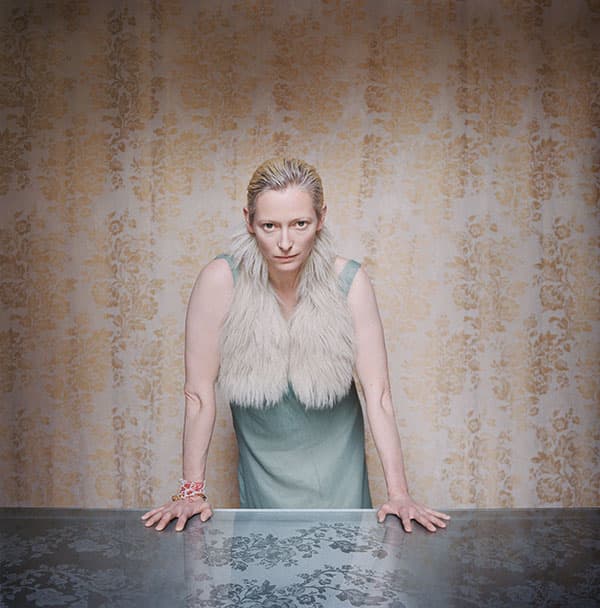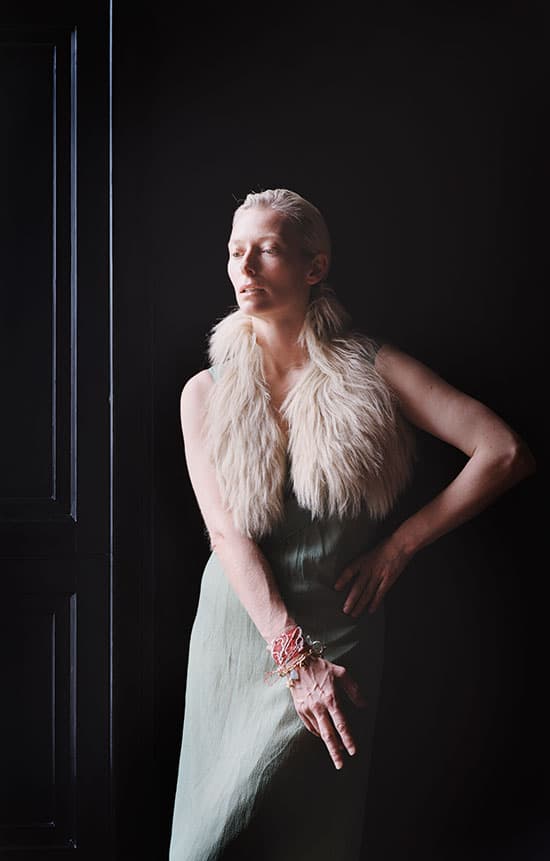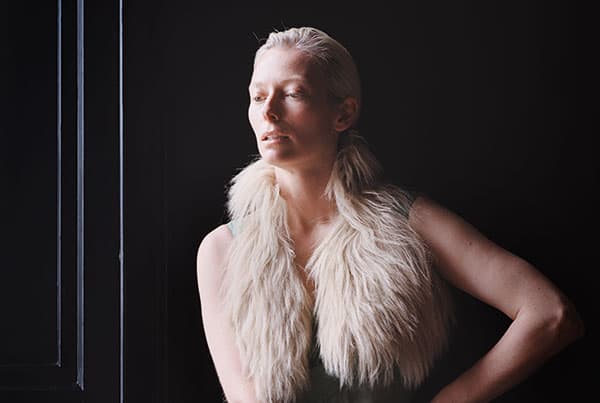
An image from the shoot in Edinburgh – Tilda was open to trying different ideas
I have a good general knowledge of popular culture, so when I’m given portrait commissions I don’t often have to research the subjects. I usually already know who the person is and what they’ve done. In the case of Tilda Swinton, I’d admired her work as an actress and model for many years before I shot her portrait.
I remember seeing a portrait of her on the cover of Time Out magazine in the early 1990s, taken by photographer Steve Double. Her appearance, with those penetrating eyes and high cheekbones, was very striking. I thought she was terrific in films such as Orlando. When I finally had the opportunity to meet and photograph her, she didn’t disappoint.
The shoot, commissioned by The Observer Magazine, took place in the summer of 2005. At that time she had been a well-known actress for more than a decade. When I photographed her she was publicising the first Chronicles of Narnia film, The Lion, the Witch and the Wardrobe, in which she played the White Witch. The pale-blue dress and faux fur she wore for the shoot echoed that character.
The Observer had arranged for me to do the shoot in what was then a fashionable Edinburgh media haunt called the Hallion. My assistant and I travelled to Scotland by plane and we did the shoot on the same day, so it was a long commute. When I met Tilda, my initial impression was that she was quite intimidating. She’s nearly 6ft [1.8m] tall and has a strong presence and a charismatic personality.
The Hallion was an amazing Georgian townhouse, with high ceilings and lots of natural light coming through the correspondingly tall windows. The building had very idiosyncratic décor – modern but with little retro flourishes – which provided an interesting environment for portraits.
I was still shooting on film at that time and took a Hasselblad CM, a Pentax 6×7 and a Fuji 6×9 rangefinder camera. We used different rooms around the building and she was very open to trying different ideas. I shot a range of images from full-length to close-up, to give the Observer’s designer a variety of shots to work with.
We shot some playful images, including some high-key close-up portraits against a white wall, using the Hasselblad with a standard lens and an extension ring. In one of them she had her eyes closed and her mouth open, like a blow-up doll. We were just messing around. She was trying different things and expressing herself. Looking back, I think this creativity, as well as her striking appearance, is what has made her the muse of so many great fashion photographers over the years.
When it comes to choosing portraits for my portfolio, I tend to go for the simpler images, often shot using daylight coming from the side, as in a Renaissance painting. I get a lot of pleasure from their simplicity. The Tilda Swinton picture I chose for my portfolio was a simple three-quarter-length portrait taken using natural light.

It was shot using the Fuji 6×9, which had a fixed Fujinon 90mm f/3.5 lens. The location was a little annexe off the bar area, which had black walls and wood panelling. Strong light was coming from her right and she was standing in an elegant pose with one arm straight and the other bent at the elbow, creating diagonal lines in the image. Rather than using a completely plain black background, I included an area on the left of the frame where the sun was picking out the shapes in the panelling. I did this to show she was in an everyday environment, rather than in a studio.
In many ways, photographing Tilda Swinton was like shooting fish in a barrel because she’s so photogenic. You could photograph her in a sloppy, haphazard way and it would still look good. However, for me it wasn’t enough to get an OK picture of her, because probably every photographer who’s photographed her will have her picture in their portfolio. I wanted to make the best of this opportunity.
I like to have an element of ambiguity in my photographs if possible, and to leave something to the viewer’s imagination, rather than telling you what to think about someone. Tilda was an ideal subject for me, because she has such an androgynous appearance.
Usually at the end of a shoot I feel I’ve got to know a subject to some extent. But in Tilda’s case, even though I was probably with her for an hour or so, I didn’t feel I got to know her any better; at the end of the shoot she still remained an enigma, which is part of her appeal.







